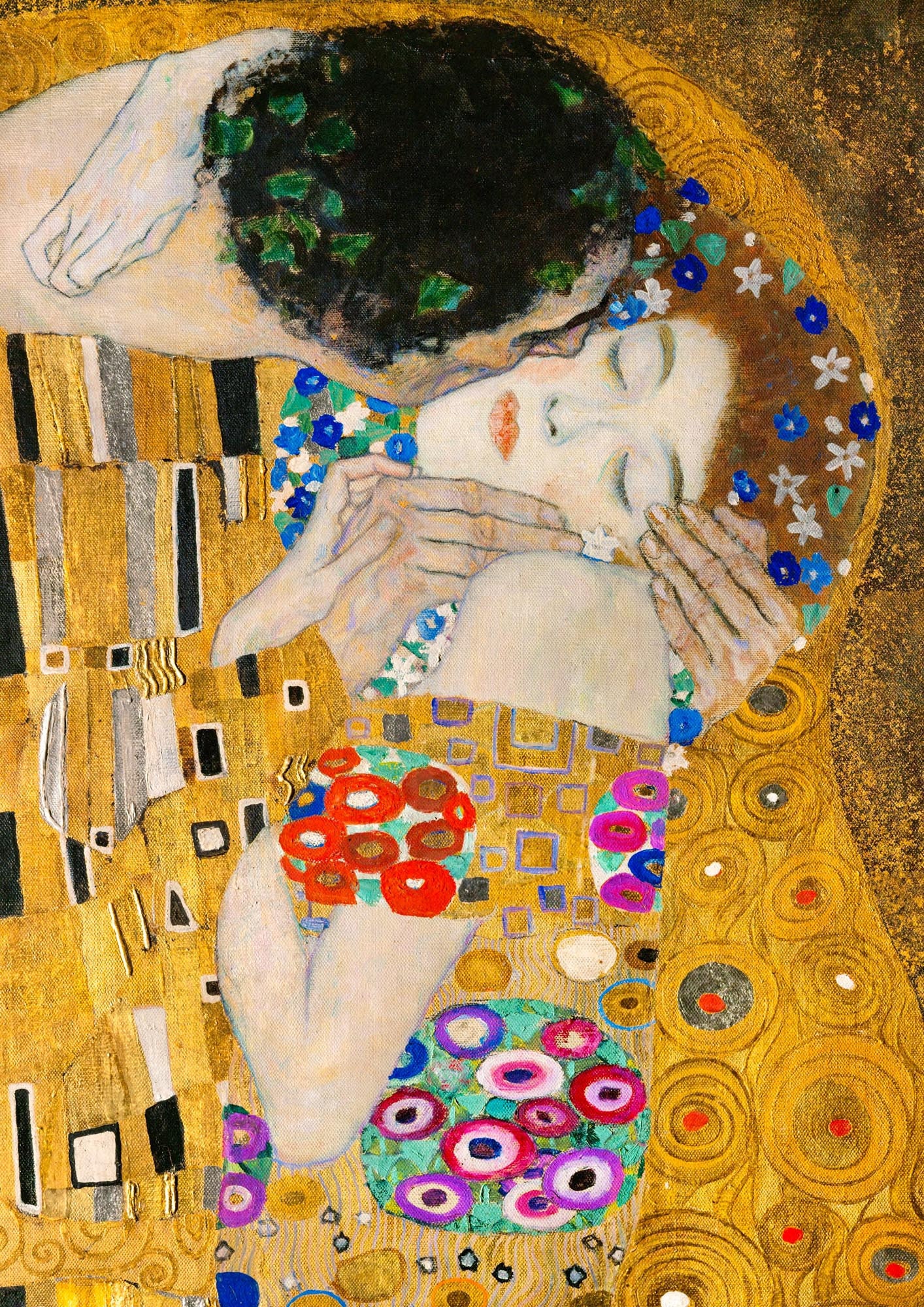
The Columbia Encyclopedia, Sixth Edition. A large oil on canvas with his signature gold leafing, this piece explores sexuality and eroticism in a. The Kiss is Klimt’s most popular work and is the culminating piece of his Golden Period.
Klimts the kiss skin#
In other works he treats the human figure without shadow and heightens the lush sensuality of skin by surrounding it with areas of flat, highly ornamental, and brilliantly composed areas of decoration. The Kiss was a much needed and instant success, selling before it was even finished, sparking both admiration and controversy from society at the time. The rhythmic flowing line and biomorphic form of Klimt's unparalleled paintings became a potent influence on the Art Nouveau movement. In "The Kiss," Klimt's best known work, beautifully rendered figures float dreamlike in space, wrapped in an abstracted mosaic robe that veils graceful organic contours.
Klimts the kiss series#
Klimt's most successful works include "The Kiss" (1908 Österreichische Gallery) and a series of portraits he did of fashionable Viennese matrons, such as "Frau Fritza Riedler" (1906 Österreichische Gallery) and "Frau Adele Bloch-Bauer" (1907 Österreichische Gallery). Heat things up and wear The Kiss by Klimt on your next date, or if youre just bumming around at home. They are exotically dressed, and their clothes are richly beautified with the decorations he took the gold color to create a vivid image from the other colors, he chose mostly brown, green and yellow. All that glitters is gold in these fab leggings. His later murals, the "Beethoven Frieze" (1902 Österreichische Gallery, Vienna) and the murals (1909-11) in the dining room of the Stoclet House, Brussels, are characterized by precisely linear drawing and the bold and arbitrary use of flat, decorative patterns of colour and gold leaf. Painting the Kiss Gustav Klimt pictured a portrait of two people, male and female, passionately kissing each other. Soon thereafter he painted three allegorical murals for the ceiling of the University of Vienna auditorium that were violently criticized the erotic symbolism and pessimism of these works created such a scandal that the murals were rejected. In 1897 Klimt's mature style emerged, and he founded the Vienna Sezession, a group of painters who revolted against academic art in favour of a highly decorative style similar to Art Nouveau.

His early work was typical of late 19th-century academic painting, as can be seen in his murals for the Vienna Burgtheater (1888) and on the staircase of the Kunsthistorisches Museum. After studying at the Vienna School of Decorative Arts, Klimt in 1883 opened an independent studio specializing in the execution of mural paintings. Gustav Klimt (18621918), The Kiss (Der Kuß) (190708), oil on canvas, 180 × 180 cm, Österreichische Galerie Belvedere, Vienna, Austria. The artist's formal training began at Kunstgewerbeschule in Vienna. Gustav Klimt (1862-1918) shocked early 20th century audiences with his unorthodox, subtly erotic paintings.īorn in Baumgarten, a suburb of Vienna, Klimt's interest in art was nurtured by his father, an engraver in gold and silver. They reveal more, such as references to Klimt’s love for Emilie Flöge and the artist’s exploration of the sculptor Auguste Rodin’s art.Austrian painter and founder of the school of painting known as the Vienna Sezession. Gustav Klimt (14 July 1862 6 February 1918) was an Austrian symbolist painter and one of the most prominent members of the Vienna Secession movement. Most recent research has, however, revealed that it is not enough to read the ornaments in the picture just as symbols rooted in tradition aiming to convey a timelessly valid message. In addition, the painting contains a myriad of motifs from various cultural epochs, above all from Ancient Egyptian mythology. Klimt gained initial inspiration for this in 1903 on a journey to Ravenna to see the Byzantine mosaics. He was able to touch the hearts of people all over the world. Instead is the portrayal of love and art, a couple. This painting is one in which Klimt deviated from his portrayal of dominant in women in the form of a femme fatale. It is also the high point of the artist’s Gold Period, which was characterized by his use of gold leaf in his work.

This coin is an example of how people saw the beauty in Gustav Klimt’s artwork. The Kiss is probably Gustav Klimt’s most famous work.

It was part of a special collector’s Austrian coin depicting Klimt in his studio and The Kiss at the backside of the coin. In this decade, the artist created a puzzling, ornamental encoded programme that revolved around the mystery of existence, love and fulfilment through art. In 2003, this beautiful painting was commemorated by the Austrian State. It undoubtedly represents the culmination of the phase known as the “Golden Epoch”. The Ministry bought it from there for the sum of 25,000 Kronen and thus secured for the state one of the icons of Viennese Jugendstil and indeed of European modern art. “The Kiss”, probably the most popular work by Gustav Klimt, was first exhibited in 1908 at the Kunstschau art exhibition on the site of today’s Konzerthaus.


 0 kommentar(er)
0 kommentar(er)
